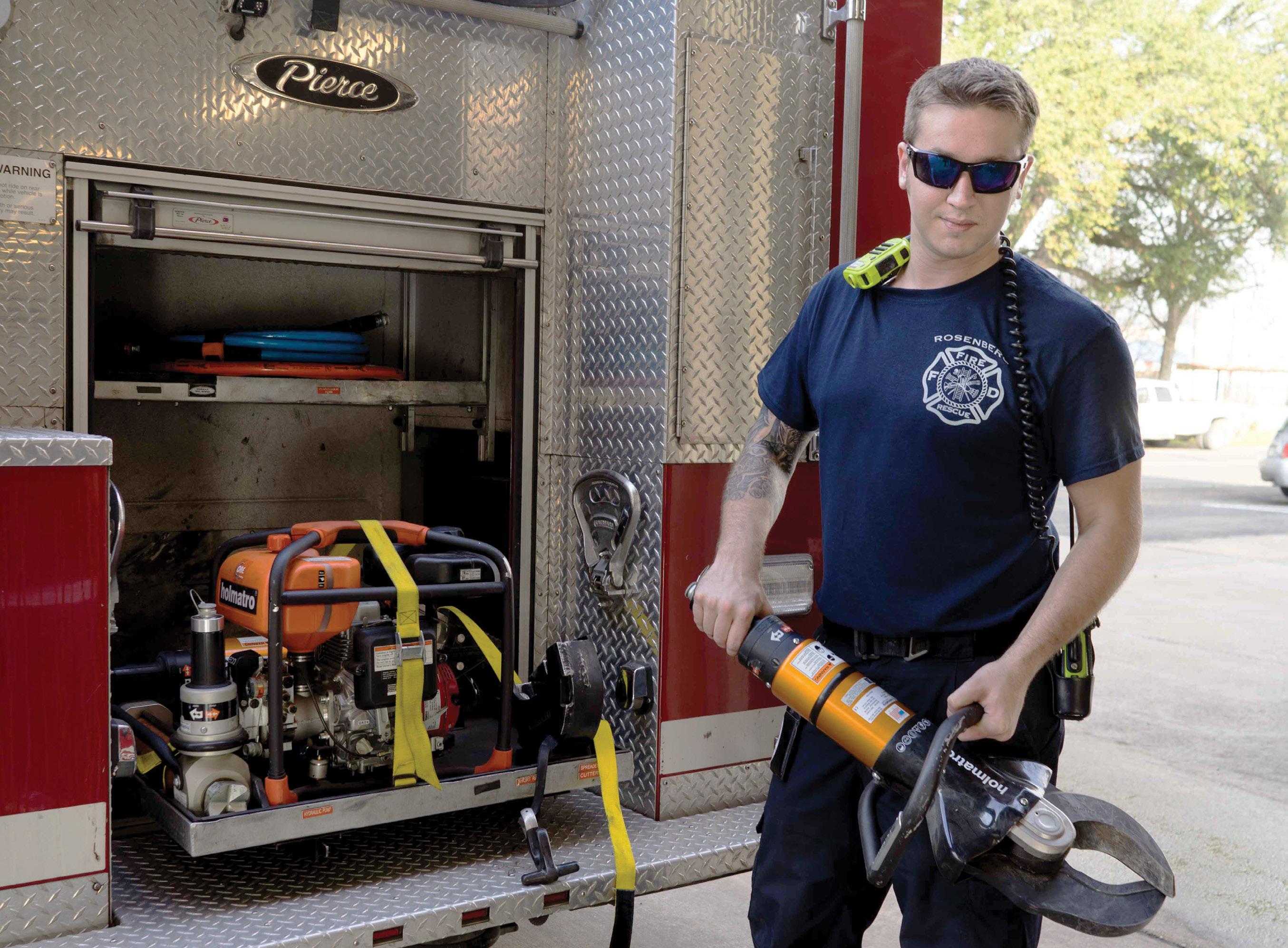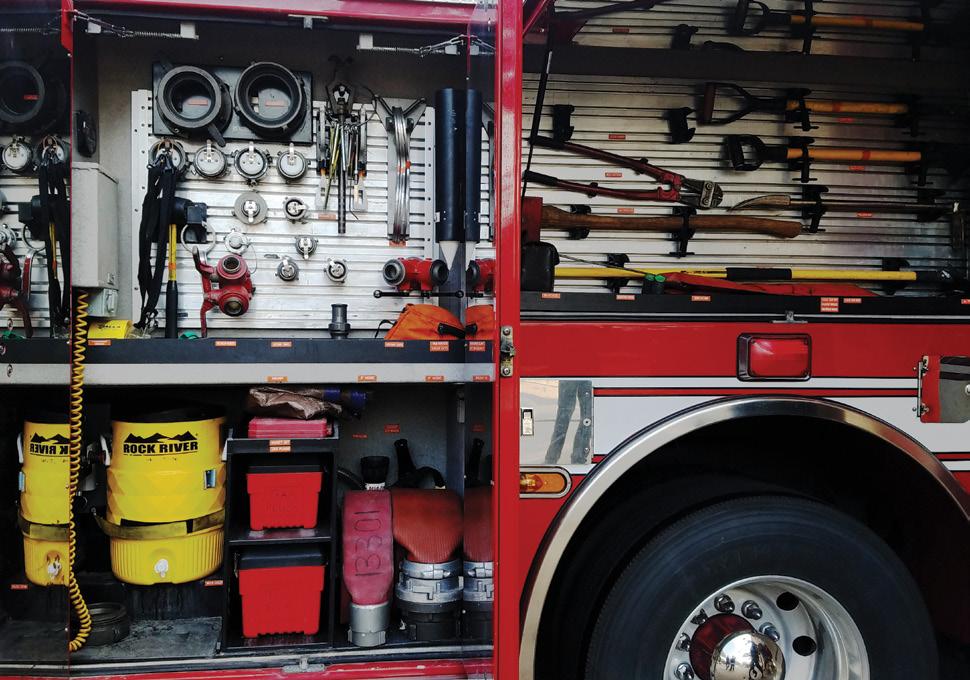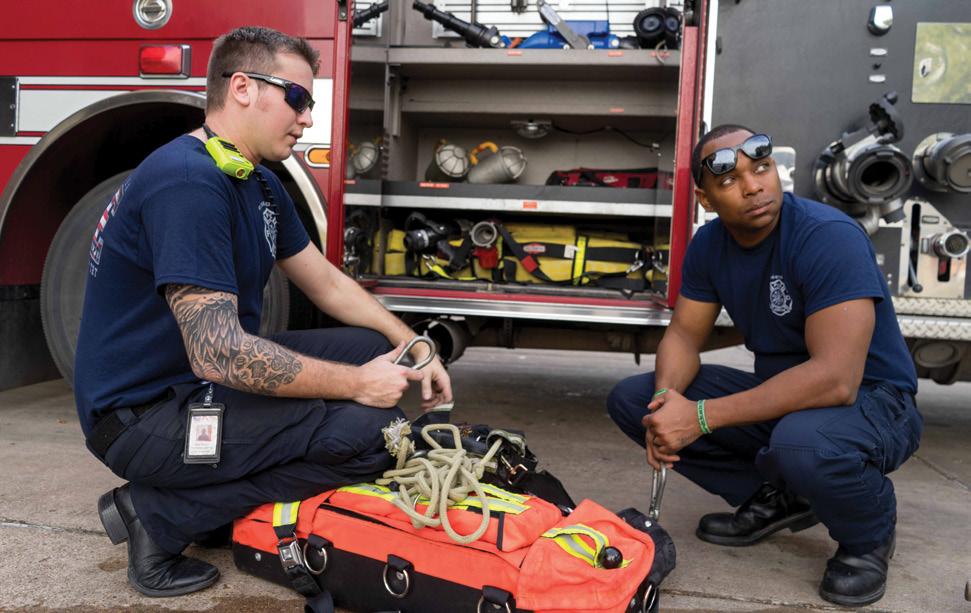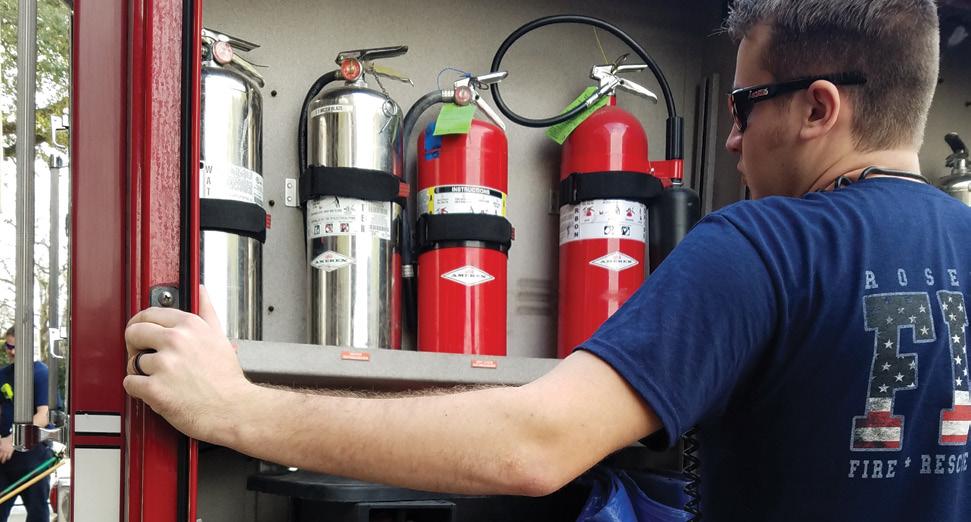
11 minute read
Rosenberg Fire Deaprtment
Fire Department
A Day in the Life
WRITTEN BY JENNY PAVLOVICH, PHOTGRAPHY BY LORENZO LERMA & JENNY PAVLOVICH
Seasoned chorizo found its way into my nose, making my stomach growl despite the microwaveable breakfast sandwich I’d inhaled as I made my way through morning traffic to Rosenberg’s Fire Station Number One. Aptly named since it is the first station built in Rosenberg, I climbed the stairs of the historic-looking building where I was greeted by Captain Jason Johns and Senior Firefighters Blain Rogers and Corey Harrison—and of course, the heavenly smell of home-made breakfast tacos.
They invited us to have a cup of coffee and tortilla full of chorizo, explaining that they like to grocery shop at several local spots to save money and get more mileage out of their meals. They sat together around a cozy looking table just outside the kitchen in a large room that had a TV and some rather comfortable looking chairs. I figured this was where everyone relaxed in between calls to the station and frankly, it wasn’t such a bad way to start the day; I told Captain Johns as much.
“Oh, we’ve been up for hours,” he said with a smile, starting on his second cup of coffee.
I glanced down at my watch and found the time still shy of 8:00 a.m.
“We’ve already been out on a call today and back,” Harrison added. “But now it’s time for breakfast!” He got up to pour another cup of coffee as Captain Johns shook his head at the Senior Firefighters who spoiled their black coffee with flavored creamers.
“We work a 48-hour shift,” Johns added. “48 hours on and 96 off starting at 7:00 a.m., typically, and ending at 7:00 a.m. two days later.”
Of course, everyone knows that an emergency can happen at any time. This particular day, for example, the team was up and responding to a call well before their alarm clocks went off. I figured it would probably take a fire to get me out of bed before my alarm too.
“Sometimes we are awake the whole shift,” Harrison told me.
The whole shift… that’s 48 hours right? Two days? I didn’t even realize it was possible to stay awake for two whole days.
As we were talking, I hadn’t even noticed that the dishes had been cleared and cleaned and now we were ready to head downstairs to check out the massive firetruck.
“Well, even when we do get to sleep, there’s a good chance it will be broken sleep,” Rogers pointed out as we descended the stairs and past an impressive hand-crafted wooden wall of hooks put together and stained by one of the firefighters, adding a personal touch to the space. “We sleep with one eye open. Even when I get home, my wife likes to give me a little space on that first day back. She knows I can be a little grouchy. Sometimes I sleep all day.” I decided not to tell them that sometimes I also sleep all day since I had never in my recollection been awake for days at a time saving lives.
“Our first morning at the beginning of each shift we check every piece of equipment on the truck,” Rogers announced as we made our way through the giant garage where the firetruck was housed along with a rescue boat, and some firefighting gear. He began opening doors and compartments I never would have known existed on the truck

Rogers opened each compartment so we could take a look at the incredible amount of equipment that they needed in order to be prepared for any scenario. There were axes and cutting tools, duffle bags full of tools and gadgets, the always intimidating “jaws of life”, a wall of gauges and meters, and of course, extra air packs.
“Air packs are also checked daily,” Rogers said pulling an SBCA (self-contained breathing apparatus) out to explain how they work. He pointed to a small translucent box on the side of the pack. “This is the T-PASS,” he said. “If ever you stop moving for an extended period of time, it will start to beep to warn you to let it know you are okay. If you don’t move after that, it will assume you are trapped, or something like that, and go into full alarm. It will update on the computer and the battalion’s ride and let them know that one of your firefighters is down. That’s why you might see a firefighter wiggle around when he’s outside; we call it the firefighter shuffle. It keeps their alarm from activating.”
He pointed out another gauge that did the same thing so that each pack had a back-up alert system. Up to this point, my visit to the fire station had been pretty fun. I got to see the guys relaxed and joking around, and it felt like they had let me in on some big secret when I got to take such a close look at the truck—but now, the reality of a firefighter’s job was really starting to set in.
Of course, I knew how they put themselves in danger every day, but actually seeing the equipment and hearing about how it worked from an actual firefighter put a face on a job that not many of us would line up to do.
The air packs also keep measure of how much air is left in the tanks. The truck has extra air tanks and the pack also has, what’s called a “buddy-line.” This allows firefighters to, in essence, share their air by equalizing their tanks. The packs will beep letting the firefighter know when it is time to change out their tank.
“Air tanks are rated to have about 45 minutes worth of air in them,” Rogers said as he returned the air pack to its rightful place tucked into the seat for easy access on the ride to a call. “Guys typically last 20-30 minutes, but I have seen a guy go through a tank in only 11 minutes.”
We continued walking around the truck, looking at various equipment. Some of it was self-explanatory, like the giant axes, or the multitude of ladders in all shapes and sizes, but some of it was unique to the field of emergency services. The Blitz Fire, for example, is set up to protect nearby buildings from spreading fire by creating a water curtain. The Holmatro is a contraption that contains the Jaws of Life and is used for extricating victims from motor vehicle accidents, or as the firemen say, MVAs.
(L-R) Blain Rogers and Corey Harrison

“This is our RIT bag,” Rogers continued. “It stands for Rapid Intervention Team and it is considered the last line of defense for the firefighters who are in a burning structure.” He opened the large, heavy-looking duffle bag and explained that it contained extra equipment like air and masks in order to replace compromised gear. “The mask is the weakest part of our gear,” Rogers said. “If it melts, a firefighter is in imminent danger.”
Looking at the masks, it was hard to envision them in a fire where, Harrison told us, it could be between 600 and 1200 degrees.
“When you go into a fire, you’re wearing 70 extra pounds of gear and equipment,” Harrison said. “You’re breathing hard before you even get to the fire.” Rogers nodded in agreement. “At fires the temperatures inside our gear can reach over 160 degrees while we’re working, so your body is over heated, you’re having to suck your air through a regulator so it’s harder to catch your breath than normal, all while you’re basically doing an intense workout and your adrenaline is going. That is why most firemen die from heart attacks and not actually fire. If you see a fireman standing around, he was probably told to rest after a lot of hard work.”
Blain Rogers
Firefighters will go in to a structure fire for about 20-30 minutes at a time and then exit the building only to prepare themselves to go in a second time. The time outside the fire is referred to as “rehab.”

“After finishing two bottles at 20-25 minutes each, you have to recharge,” Harrison said. “You rehab. You hydrate. You breathe air. At this point, your heartrate and blood pressure are way up. This is when a fresh crew goes in.”
I looked back down at the RIT bag that Rogers was putting away and asked if that was the RIT team that went in as the fresh crew.
Rogers shook his head. “No, the RIT team is there in case of an emergency for the crew inside. Your job on the RIT team is not to exert yourself. You’re preparing to save a life.”
Rope lines with a series of knots and rings guide members of the RIT team in their efforts to search for and rescue a crew member in danger. The rope helps them to find their way in and out of an environment black with smoke and difficult to see, allowing them to follow the path out and know how far they have gone into the structure.
“Ideally you would have four people on a RIT team,” Harrison said. “We usually try to have at least two or three. It can take 12 people to save one firefighter.”
Before I had a chance to let that sink in, everyone’s radio went off and the whole Fire Station One crew was loading into the truck before I had a chance to figure out an emergency call had just come in.
“If it’s a fire, we get dressed outside the truck,” Rogers said, pointing out quickly where they had even more
gear inside the truck. “On the way to the call we put on the air packs. This is a medical call and we get more of those than actual structure fires.”
I climbed into the seat behind Rogers, who was the driver, and he shot me a look that suggested everyone was waiting on me.
“What?” I asked.
“Seatbelt!” everyone chorused. To think, I’d almost forgotten.
With that important safety concern out of the way, we were off with full lights and sirens, maneuvering through the streets to a life alert call. Just like Rogers said, last minute gear was adjusted en route and I was handed a pair of safety glasses to put on.
On the scene we met with Fort Bend County EMS and the emergency crews quickly ascertained that the victim was okay, but not before a brief struggle to get into the house.
After all that action, I figured we would go back to the station and sit in some of those comfy looking chairs. Maybe even put our feet up. But this crew has a jampacked schedule. We only spent a moment back at the station where everyone changed into blue, button-down shirts that are for any time you’re not on a call, but not at the station. Then, Harrison loaded the back seat with two large coolers.
“Every day, we deliver Meals on Wheels to Rosenberg citizens,” Harrison said as Rogers turned up the volume on his favorite Fleetwood Mac song. “After this, we will head back to the station and start on our reports for the call we just went out on.”
Rosenberg firefighters attend a training session.

In between calls, Johns, Rogers, and Harrison checked and inventoried all the station equipment, attended hazardous railroad safety training with BNSF, and met with a group of elementary school kids, talking to them about fire safety.
“Talking to kids at school is something that we do on a regular basis,” Rogers said. “Almost every shift we go talk to kids somewhere, not only about fire safety, but so we can prevent them from being scared

of seeing a fireman in full gear. It teaches kids not to hide from firefighters or to be afraid.”
Community outreach is very important to the Rosenberg Fire Department. They attend events like National Night Out and host Fire Department Open Houses. They even install smoke detectors with the American Red Cross.
“One of our favorite initiatives is called Operation Baby Safe,” Rogers said. “Parents of babies born in Rosenberg hospitals can sign up to have smoke detectors installed and get trained on proper usage.”
Even with all these positive and uplifting ways that the fire department makes a difference in their community, I couldn’t help but wonder what made Harrison and Rogers want to become firefighters—a job where you put your life on the line every day. There definitely wasn’t much downtime. And it takes an incredible amount of courage and physical strength.
Rogers agreed with a laugh. “I think the main reason we all do it because we want to help people, and I guess I’m a bit of a thrill seeker too. I like that there is always something different happening and that we’re expected to be a Jack of all Trades.”
I thought to myself, “I could never be a firefighter.”
Rogers shook his head in thought. “I couldn’t do anything else.” v
R O S E N B E R G Fire Department
(832) 595-3600 4336 Hwy 36 S. • Rosenberg, TX 77471 www.ci.rosenberg.tx.us










